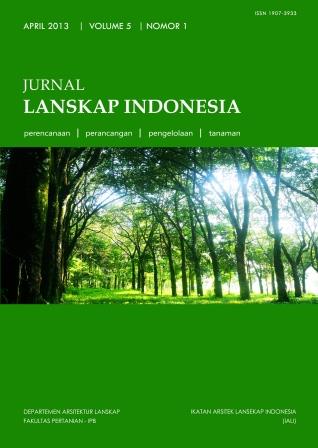KAJIAN POTENSI LANSKAP JALUR KERETA REL LISTRIK (KRL) BOGOR -JAKARTA KOTA SEBAGAI KORIDOR PERGERAKAN BURUNG
Abstract
ABSTRACTCorridors are narrow strips of land which differ from the matrix on either side. There are two types of corridors, namely linear corridor and stepping stone. One example of corridor is a landscape along the path of KRL Railway Bogor-Jakarta Kota. Corridor is important for bird movement. Nowadays there is habitat fragmentation along the corridor which is threatened their corridor function. Therefore it should be maintained for sustainable corridor. This study was conducted at corridor along the KRL Railway Bogor-Jakarta Kota which is divided into five segment. Three analyses were used in this study, i.e. corridor distribution analysis, vegetation analysis and bird abundance analysis. Stepping stone corridor has higher number of bird abundance than the linear corridor. Both of corridors have the potential to become a habitat of birds which is indicated by abundance species of birds. The highest abundance of a bird was found in corridor with diversity of plants (Shannon Wienner Index) in the medium level. Several recommendation have provided for managing the corridor such as managing and revitalizing the corridor, increasing vegetation diversity and increasing public awareness for bird habitat conservation
Keywords : birds, GIS, habitat fragmentation, linear corridor, stepping stone
Downloads
This journal permits and encourages authors to post items submitted to the journal on personal websites or institutional repositories both prior to and after publication, while providing bibliographic details that credit, if applicable, its publication in this journal. However, after the article is submitted and published in this journal, it is fully copyrighted by the Jurnal Lanskap Indonesia or JLI. If excerpts from other copyrighted works are included, the author must obtain written permission from the copyright owner and give credit to the source in the article. Then, the writer or reader is allowed to copy, share, and redistribute articles/material in any form. But it must still include the appropriate source and credit because the article in this journal is licensed by Creative Commons Attribution 4.0 International License (CC BY 4.0).
I. Proposed Policy for Journals That Offer Open Access
Authors who publish with this journal agree to the following terms:
- Authors retain copyright and grant the journal right of first publication with the work simultaneously licensed under a Creative Commons Attribution License that allows others to share the work with an acknowledgement of the work's authorship and initial publication in this journal.
- Authors are able to enter into separate, additional contractual arrangements for the non-exclusive distribution of the journal's published version of the work (e.g., post it to an institutional repository or publish it in a book), with an acknowledgement of its initial publication in this journal.
- Authors are permitted and encouraged to post their work online (e.g., in institutional repositories or on their website) prior to and during the submission process, as it can lead to productive exchanges, as well as earlier and greater citation of published work (See The Effect of Open Access).
II. Proposed Policy for Journals That Offer Delayed Open Access
Authors who publish with this journal agree to the following terms:
- Authors retain copyright and grant the journal right of first publication, with the work after publication simultaneously licensed under a Creative Commons Attribution License that allows others to share the work with an acknowledgement of the work's authorship and initial publication in this journal.
- Authors are able to enter into separate, additional contractual arrangements for the non-exclusive distribution of the journal's published version of the work (e.g., post it to an institutional repository or publish it in a book), with an acknowledgement of its initial publication in this journal.
- Authors are permitted and encouraged to post their work online (e.g., in institutional repositories or on their website) prior to and during the submission process, as it can lead to productive exchanges, as well as earlier and greater citation of published work (See The Effect of Open Access).



























